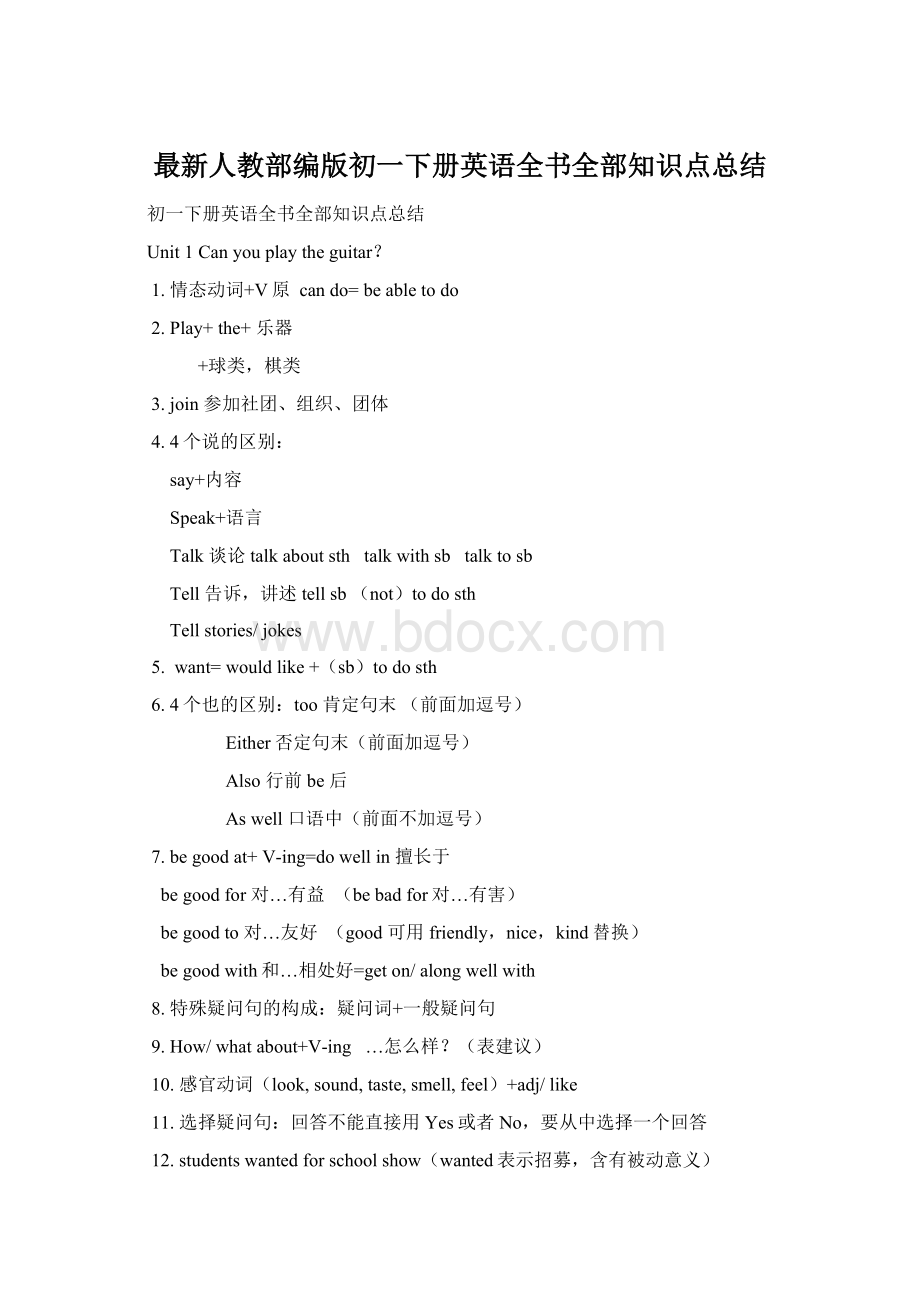最新人教部编版初一下册英语全书全部知识点总结Word文件下载.docx
《最新人教部编版初一下册英语全书全部知识点总结Word文件下载.docx》由会员分享,可在线阅读,更多相关《最新人教部编版初一下册英语全书全部知识点总结Word文件下载.docx(16页珍藏版)》请在冰豆网上搜索。

5.
want=wouldlike+(sb)todosth
6.
4个也的区别:
too肯定句末(前面加逗号)
Either否定句末(前面加逗号)
Also行前be后
Aswell口语中(前面不加逗号)
7.
begoodat+V-ing=dowellin擅长于
begoodfor对…有益
(bebadfor对…有害)
begoodto对…友好
(good可用friendly,nice,kind替换)
begoodwith和…相处好=geton/alongwellwith
8.
特殊疑问句的构成:
疑问词+一般疑问句
9.
How/whatabout+V-ing
…怎么样?
(表建议)
10.
感官动词(look,sound,taste,smell,feel)+adj/like
11.
选择疑问句:
回答不能直接用Yes或者No,要从中选择一个回答
12.
studentswantedforschoolshow(wanted表示招募,含有被动意义)
13.
showsthtosb=showsbsth
givesthtosb=givesbsth
14.
helpsb(to)dosth
Helpsbwithsth
Withsb’shelp=withthehelpofsb
Helponeselfto随便享用
15.
bebusydoingsth/bebusywithsth
16.
needtodosth
17.
befree=havetime
18.
havefriends=makefriends
19.
callsbat+电话号码
20.
ontheweekend=onweekends
21.
English-speakingstudents说英语的学生(带有连词符,有形容词性质)
22.
dokungfu表演功夫
Unit2Whattimedoyougotoschool?
问时间用whattime或者when
At+钟点
at7o’clock
atnoon/atnight(during/intheday)
On+具体某天、星期、特指的一天
onApril1st
onSunday
onacoldwintermorning
In+年、月、上午、下午、晚上
时间读法:
顺读法
逆读法:
分钟≤30用past
fivepasteight(8:
05)halfpasteight(8:
30)
分钟>30用to
aquartertoten(9:
45)
整点用…o’clock
7o’clock(7:
00)
3个穿的区别:
wear表状态,接服装、手套、眼镜、香水等
Puton表动作,接服装
Dress表动作,接sb/oneself
getdressed穿衣
from…to…
be/arrivelatefor
频度副词(行前be后)
Always
usually
often
sometimes
seldom
hardly
never
一段时间前面要用介词for
forhalfanhour
forfiveminutes
eat/have…forbreakfast/lunch/dinner/supper
either…or
alotof=lotsof
itis+adj+forsb+todosth(adj修饰todosth)
ItisimportantformetolearnEnglish.
itis+adj+ofsb+todosth(adj修饰sb)
Itiskind/friendly/niceofyoutohelpme.
感叹句:
How+adj+主谓!
How+adj+a/an+n单+主谓!
What+a/an+adj+n单+主谓!
What+adj+n复/不可数+主谓!
Unit3Howdoyougettoschool?
疑问词
How如何(方式)
howlong多长(时间)答语常用“(For/about+)时间段”
howfar多远(距离)答语常用“(It’s+)数词+miles/meters/kilometers”
howoften多久一次(频率)答语常用“Always/often/everyday/…”或“次数+时间”等表频率的状语
Howsoon多快,多久以后,常用在将来时中。
答语常用“in+时间段”
howmany多少(接可数名词)
howmuch(接不可数名词)
why为什么(原因)
what什么
when何时
who谁whom谁(宾格)(针对宾语提问也可用who)
whose谁的
宾语从句要用陈述句语序
Stopsbfromdoingsth
Stoptodo停下来去做其他事
Stopdoing停止正在做的事
whatdoyouthinkof/about…?
=howdoyoulike…?
你认为…怎么样?
Heis11yearsold.
Heisan11-year-oldboy.
manystudents=manyofthestudents
beafraidofsth
beafraidtodosth
worryabout
beworriedabout担心
playwithsb
cometrue
havetodosth
heislikeafathertome(like像)
leave离开
leavefor出发前往某地
cross是动词
across是介词
thanksfor+n/V-ing
Thanksforyourhelp/thanksforhelpingme.
Thanksforyourinvitation/thanksforinviting/askingme.
Thanksto幸亏,由于,因为
4个花费:
人+spend/spends/spent+时间/钱+(in)doingsth/onsth
人+pay/pays/paid+钱+forsth
Ittakes/tooksb+时间+todosth
物+cost/costs/cost+sb+钱
交通方式
●用介词。
在句子中做方式状语。
①by+交通工具名词(中间无需任何修饰)
Bybus/bike/car/taxi/ship/boat/plane/subway/train……
②by+交通路线的位置
Byland/water/sea/air
③in/on+冠词/物主代词/指示代词+交通工具名词
Ina/his/thecar
Ona/his/thebus/bike/ship/train/horse/motorbike
④onfoot步行
●用动词。
在句子中做谓语。
①take+a/the+交通工具名词
takeabus/plane/ship/train
rideabike
②walk/drive/ride/flyto……(后面接here,there,home等地点副词时,省略介词to。
)如步行回家:
walkhome
名词所有格
(1)一般情况加’s
Tom’spen
(2)以s结尾加’
theteachers’office
tendays’holiday
(3)表示几个人共同拥有,在最后一个名词后加’s
MikeandJohn’sdesk
(4)表示每个人各自拥有,在每个名词后加’s
Mike’sandJohn’sdesks
Unit4Don’teatinclass
祈使句(变否定在句首+don’t)
Be型(be+表语),否定形式:
don’t+be+表语
Bequiet,please.
Don’tbelate!
Do型(实义动词+其他),
否定形式:
don’t+实义动词+其他
Comehere,please.
Don’tplayfootballhere.
Let型(letsbdosth),
don’t+letsbdosth或者letsbnotdosth
No+n/V-ing
Nophotos/mobile;
Noparking/smoking/spitting/talking/pickingofflowers
inclass在课堂上
intheclassroom在教室
beontime准时
listentomusic
(havea)fightwithsb
eatoutside
Must与haveto
(1)must表示说话人主观上的看法,意为“必须”。
haveto表示客观的需要或责任,意为“不得不,必须”,后接动词原词。
(2)must没有人称,时态和数的变化Haveto有人称,数,时态的变化,其第三人称单数形式为hasto,过去式为hadto.构成否定句或疑问句时借助动词do/does。
(3)haveto的否定式是needn’t=don’t/doesn’thave